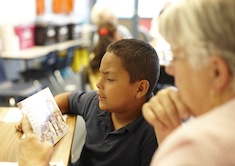August 31, 2013
10 Back to School Reading Tips for Parents and Guardians
It’s that time of year again. By now summer break has come to an end and most kids are back in school. For Reading Partners tutors, this means it is time to return to our reading centers to begin one-on-one sessions with our students. The Reading Partners program works because it provides targeted instruction at the pace students need to master multiple literacy skills.
 As we look ahead to another year of helping students narrow their reading achievement gap, we are deeply aware of the importance of children reading with their parent or guardian at home. Reading at home is invaluable to a child’s academic development. Research has shown that one-on-one reading time and access to books are important predictors of future literacy skills and, inevitably, future educational outcomes. Children who aren’t given the opportunity to read as often fall behind in school, with difficulties following them through middle school, high school, and beyond. Consider this: if “the absence of parental involvement can lower average reading scores by 74%,” then imagine how far a little at-home reading can go (USC Rossier School of Education).
As we look ahead to another year of helping students narrow their reading achievement gap, we are deeply aware of the importance of children reading with their parent or guardian at home. Reading at home is invaluable to a child’s academic development. Research has shown that one-on-one reading time and access to books are important predictors of future literacy skills and, inevitably, future educational outcomes. Children who aren’t given the opportunity to read as often fall behind in school, with difficulties following them through middle school, high school, and beyond. Consider this: if “the absence of parental involvement can lower average reading scores by 74%,” then imagine how far a little at-home reading can go (USC Rossier School of Education).
Here are some easy ways that parents or guardians can help children become strong, successful readers:
1. Set a routine.
Setting routines for mornings and evenings—including nutritious meals and an early bedtime—helps children cope with stresses that may arise from starting a new school year. Routines have many benefits, namely, children feel comfortable and stable in their environment, resulting in more cooperative behavior inside and outside of school. Children who are overtired, who eat too many fatty or sugary foods, or who are coping with inconsistent schedules are prone to behavioral problems and may find it increasingly difficult to concentrate in school.
2. Read at home.
Reading regularly at home provides children with the practice they need to become great readers. Remember, “The more kids read, the better they read,” and the same holds true for the opposite effect, “the less kids read, the poorer they’ll read.” Beyond practice time, reading at home reinforces a positive attitude around reading—kids start to enjoy reading!
The best way to incorporate reading in the household is to devote 20 to 40 minutes, at the same time every evening, to family reading time. Make it part of a routine, as discussed in tip #1. Another fun idea is to have children read to their pets, siblings, or stuffed animals, like a game.
3. Make a special reading spot.
Designating a special reading spot for children to read with their parents guardians is not only fun, but is also a great way to create a distraction-free zone where children can concentrate. The reading spot should be rid of any extraneous noise, toys, etc. Putting some pillows or a comfy chair in the corner of a living room and surrounding the area with books is a great way to go.
4. Be a great reading partner!
It’s no fun to read when you’re forced to or feel embarrassed and ashamed to read. Building trust and supporting a child reader is crucial as a reading partner. Here are some tips for becoming a great reading partner:
- Be patient and encouraging.
- Read aloud and track the words with your finger as you are reading.
- Read the same stories over and over. Try reading the same stories in different ways, with different voices to make it fun and interesting.
- Ask questions about the story while you’re reading to gauge comprehension.
- Pick books that are at the right level for your young reader—5+ mistakes on one page is too hard. No mistakes or only one mistake per page is too easy.
- Gently correct mistakes and re-read the entire sentence.
- Give positive feedback and tell the reader he or she is doing a great job.
- NEVER: Bribe, nag, criticize, judge, or add pressure by making a big deal about reading.
 5. Surround your child with books.
5. Surround your child with books.
According to Science News, research shows that the number of books in the home is a strong indicator for reading achievement and educational attainment. When children have access to books in their home, they become familiar with books and the act of reading, effectively giving them a head start in learning. A child who looks at books and reads with his or her parents/guardians everyday has a major advantage compared to children who never read at home and who have never been introduced to the concept of reading. Simply interacting with books on a regular basis makes a huge difference in a child’s development.
6. Bring books everywhere.
Incorporating books into everyday activities will continue to help children become more familiar with books and will encourage everyday reading. Place books in every room of the house, in the car, and take books everywhere. Remember, according to the Family Education Network, children with an array of reading materials around them and in their homes score higher on standardized tests.
7. Set a good example; be caught in the act!
Children are a product of their upbringing and mimic the behavior they see at home, repeating the actions they observe from their parents or guardians. If a child observes his or her parent/guardian reading every night, then that child will emulate the same behavior. On the contrary, if a child observes their guardian watching TV every night while they are ordered to read their books from school, then the child might start to resent reading and desire to watch TV.
8. Communicate with teachers and get involved in your local school.
Speaking with the adults that children talk to is one way parents and guardians can relate to their child’s daily activities. Another way to relate to a child’s daily activities at school is to volunteer in the classroom or attend a class fieldtrip. Knowing what goes on in the classroom and during the school day helps parents relate to their child’s experiences, sparking conversations and an interest in school activities. Understandably, it can be difficult for many working parents to take time off of work to spend in the classroom. Nonetheless, it is important to talk with educators on a regular basis and attend open houses and parent-teacher conferences when possible.
Communicating with teachers also informs parents and guardians in what areas their children are succeeding and where their students might need more help. Don’t wait for teachers to call—call teachers or visit the classroom for monthly check-ins. Address challenges with support, guidance, patience, and practice.
9. Set learning goals.
Talking with children about what they would like to accomplish during the school year will help them start to learn the invaluable skill of goal setting. Working with children to set achievable goals can encourage children to achieve their reading goals. For example, Sally is a second grader and is having trouble stringing words together because she has to sound out every word. Sally’s mom talked to Sally about some ways they could work on helping Sally become a faster reader. One idea they had was to read some of the same books over and over again. Another idea they had was to read some of Sally’s kindergarten books and work up to stringing together bigger words.
10. Be enthusiastic!
Positive attitudes are very important to a child’s reading development and generate a desire to read. Showing genuine excitement for childrens’ reading skills will encourage them to become great readers. Struggling readers may start to develop a negative attitude towards reading, but showing them that reading can be fun will get them excited about reading time. Great times to praise a child when he or she is reading include, when he or she sounds out a difficult word, self-corrects and re-reads a sentence, or asks questions as he or she is reading.
Photos via Compfight / Respect Task Force / Dalla*










